Two of the most fascinating aspects in the currently premiering sequel of the Spider-Verse trilogy, are the further concept of the Multiverse and the way it operates, and the introduction of even more Spider-Man variants in the Spider Society. It seems that Sony takes the concept of variants too seriously, they even release the animated movie’s own variant in theaters.
That’s right, there are currently two different versions of Spider-Man: Across the Spider-Verse at the box office, and of course, there are some notable changes that we’ll find if we pay attention closely. These are just minor changes, which don’t affect the overall flow of the story at all, but it’s always nice to see that bit of extra detail that the producers added into the movie on purpose. Let’s take a look at these 11 differences between the two movies right away, which are put chronologically in this list, to see what Sony has in store for this second version.
#1. Gwen Stacy’s encounter with Miguel O’Hara.
 Source: Sony Pictures Entertainment
Source: Sony Pictures Entertainment
One of the most anticipated Web-Slingers to appear in the movie, Miguel O’Hara, aka Spider-Man 2099, makes his intimidating entrance at the start of the movie, however, it doesn’t impress Gwen one bit. In one version, the heroine pokes fun at Miguel’s superhero name, guessing it “Blue Panther”, following up with “The Caped Blue-Cader”, “Dark Garfield”, and “Macho Libre”, to which the latter replies: “That’s funny”. In the other version, this exchange is nowhere to be found, though. Who said Miguel doesn’t have a sense of humor?
#2. Miguel’s first interaction with Lyla.
 Source: Sony Pictures Entertainment
Source: Sony Pictures Entertainment
Lyla is a nice introduction to the movie, who’s Miguel’s own rebellious and snarky AI. In one version, after Spider-Man 2099 finally admits that he needs her help, Lyla shows her playful side a bit by taking a selfie with him using a bunny filter, which makes the latter look extra cute for no particular reason. In the other, her hologram just simply poses and teases Miguel before stating that she has already made the backup call.
This scene is one of the most notable differences between the two films, and thanks to it, the audience was able to discover the animated sequel actually has two unique versions.
#3. Miguel’s fight vs The Renaissance Vulture.
 Source: Sony Pictures Entertainment
Source: Sony Pictures Entertainment
In both versions, when these two fight on the rooftop, a helicopter appears and orders them to surrender (really?). In one version, we see Spider-Man 2099 threaten to bite the villain using his fangs, but the other just skips straight to the helicopter scene.
#4. The Spot’s appearance.
 Source: Sony Pictures Entertainment
Source: Sony Pictures Entertainment
We all know the Spot is actually much more dangerous than what we gave him credit for, but it’s hard to take him seriously with all the silly antics and quippy lines that the villain made. During his first encounter with Miles, the Spot says “Now look at me” in one version, while exclaiming “Give me back my foot” in the other, getting confused by the portals.
Anyway, we’d love to hear more of his quips in Beyond the Spider-Verse, even if he has become a dangerous multi-dimension entity that can wipe out the balance of the Multiverse.
#5. Jeff Davis’s fight with the Spot.
 Source: Sony Pictures Entertainment
Source: Sony Pictures Entertainment
Well, it’s actually not a fight, since the officer was only a victim in Miles and the Spot’s cat-and-mouse game. In a version, Jefferson falls into a portal, luckily lands on a surface, gets up, and then makes a slight complaint. The other movie just barely shows his face and then skips straight to Miles’s fight.
#6. Gwen Stacy looking at The Spot’s hologram.
 Source: Sony Pictures Entertainment
Source: Sony Pictures Entertainment
Much to Miles’s disappointment, Gwen is primarily in his universe to investigate the hole villain. Using Miguel’s latest hologram technology, the heroine tracks after what the Spot was doing in the past, which he said “Which would not be good” in one version, and “Oh, what the heck” in the other, before starting the collider. The outcome is dreadful all the same, though.
#7. The “Chai Tea” part.
 Source: Sony Pictures Entertainment
Source: Sony Pictures Entertainment
Don’t get mad at me for saying this, Pavitr. In Mumbattan, Spider-Man India gives Miles a good pep-talk about saying “chai tea”, which is no different from saying “tea tea”, and then asks the latter if they say “coffee coffee” in his universe. In one movie, Miles replies “Sorry” repeatedly, while denying “No! No!” in the other. Easily one of the most hilarious sequences in the movie.
#8. Hobie Brown’s entrance.
 Source: Sony Pictures Entertainment
Source: Sony Pictures Entertainment
Hobie literally makes his entrance with a bang, breaking the barrier between Miles and the Spot, and follows up with some sick guitar riffs. In one of the versions, a “Hobie” text briefly appears above his head, while the other has none. It’s still an epic scene to say the least, and is why we all love this rebellious Spider-Man variant.
#9. Gwen looking for Miles after he saved Captain Singh.
 Source: Sony Pictures Entertainment
Source: Sony Pictures Entertainment
After Miles saved Captain Singh, Gayatri’s father, which is dubbed by Miguel as a disturbance to the canon event, the two crash into the bridge, and everything collapses on them. Gwen, fearing that Miles might have lost his life in the process, panickingly finds him under the rubble. In one version, Gwen says a few words while looking for him, such as “Oh no”, and “Please don’t”, while in the other one, she just shakes her head and doesn’t say anything.
#10. Ben Reilly’s rare interaction with Miles.
 Source: Sony Pictures Entertainment
Source: Sony Pictures Entertainment
Ben Reilly/Scarlet Spider is also a much-anticipated version of Web-Slinger in the animated movie, and his interaction with Miles, while rare, also differs in both movie versions. In one of them, after locking Miles in his arms during their fall, Ben says: “I’ve got you trapped in my well-defined musculature, so don’t even.”, while flexing “This one is called the sleeper holder, I’m using my bicep to constrict your…” in the other. It doesn’t matter though, since Miles briefly makes his escape afterward with relative ease.
#11. Mary Jane’s line with her husband.
 Source: Sony Pictures Entertainment
Source: Sony Pictures Entertainment
We’re all glad to see Peter B. Parker manages to turn his life around, reconcile with MJ, and they even have a daughter, Mayday. We also get to see their interaction when Peter comes back to his reality, MJ welcomes her husband with “Hi, huh. How was work” in one version. On the other, the “Hi, huh” is missing. Of course, Peter avoids mentioning him bringing along Mayday for his Spider Society shenanigans, but MJ easily sees right through his lies.
What do you think about these slight adjustments in both movies? Would you want to watch Spider-Man: Across the Spider-Verse again? Let us know in the comment.